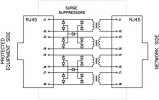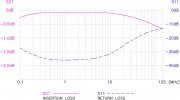lets talk about ethernet noise... the audio boogie man... by referencing ethernet in the real world... a data center.
Below we see a single row in a datacenter made up off individual racks...each 19" wide and typically 8ft high.
Servers/and or ethernet devices (switches etc) of different heights will slot into these racks and a datacenter building might contain 100's of these rows.
At the end of each row will typically by a very large UPS providing the localized power for each row.
Note the yellow, green and blue ethernet cables.
These racks are electrically very noisy... lots of emi/emf from the power being feed to the servers, the UPS's themselves, the servers themselves etc.
Above the rack row will be trays that hold all the ethernet cables and in the left picture you can see these being bundled off to serve each individual rack. The right picture is a top level view. The amount of ethernet cabling in a datacenter is mind blowing.
Finally at some point these cable bundles will concentrate together so they can all connect into switches and internet facing routers or to go between buildings etc.
So what does this tell us:
1- that ethernet and its associated devices are designed to work in exceptionally noisy environments (noting the voltage on ethernet is less then 5V)
2- much of the cabling in a data center wont be fancy cat 7 / cat 8 but the workhorse UTP cat6 from the rack rows out
3- the design of UTP ethernet (unshielded) is such that its noise suppression is so good there is no issue bundling it together or running it close to emi/emf sources
4- Thus it is not susceptible to the high levels of emi/emf in a data center
5- devices (rackable computers etc) dont have fancy "milled from a single block" cases.. just folded steel that needs to meet a minimum of emi/emf emission standards (i.e. they dont do ethernet runs any favours)
6- the cables will be made using commodity wiring/terminators... no fancy sheaths,connectors, 99.99999% copper etc... they need to be as cheap as possible but reliable.
7- no fancy reclockers needed cause TCP/IP is a packetized protocol
8- similarly network devices connected via 70m/80m/90m of ethernet dont need reclockers to allow the ethernet electrical signals to be reliably sent
9- and maybe most importantly, your FLAC stream is just data the ethernet/tcpip stack doesnt care if its a video stream, and audio stream or a cat photo, the data will be sent and received with the same level of reliablity and nothing more needs to be added to make it more reliable (noting that within datacenters, certain type of data might be given priority over other data, via QOS or quality of service configs)
So there is no way a short single run of ethernet from your router to your streamer (or PC/NAS to streamer) is going to stress the noise suppression of the end to end ethernet transmission line.
Only need to use cat 6, dont need reclocking switches but if you really want, spend less than $100 on a real world filter (as I highlighted) or say a pair of tplink mc200cm convertors and suitable fibre cable
Peter

 stackaudio.co.uk
stackaudio.co.uk

 stackaudio.co.uk
stackaudio.co.uk



